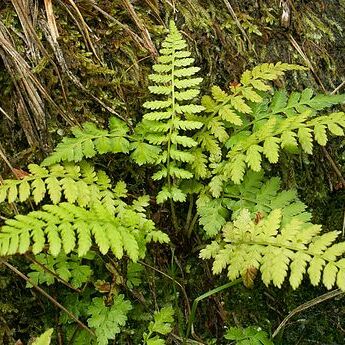Plants small, summer-green. Rhizomes long or shortly creeping, blackish brown, glabrate or densely red-brown pubescent, sparsely scaly; scales brown or brownish, thin, ovate to broadly lanceolate. Fronds distant, approximate, or caespitose, thin; stipe dark brown at base, upper part stramineous or chestnut-colored; lamina 2-or 3-pinnate, rarely 4-pinnate or more divided, ovate-lanceolate, ovate-triangular, or subpentagonal; pinnae with anadromous pinnules, shortly stalked, unequally sided or subequilateral at base; minutely toothed at segment margin; veins free, forked or pinnate, terminating in teeth or emarginations. Lamina thinly herbaceous or herbaceous, green when dried, stipe, rachis, costae, and costules with few small scales at base, and multicellular hairs or unicellular glandular hairs, lamina usually glabrate. Sori orbicular, abaxial on veins, sorophore slightly protuberant, annulus of sporangium consisting of 14-16 cells; indusia ovate, lanceolate, orbicular, or shallowly cup-shaped, attached at proximal side of sorophore, membranous, persistent, covering sporangia when young, hidden at maturity. Spores bilateral, dark brown, bean-shaped, perispore usually with spines, rarely with folds. x = 42.
Terrestrial ferns. Rhizomes slender, blackish, decumbent or creeping, scaly. Fronds 2-3-pinnate, sparsely scaly, delicate, often dying down in winter; veins free. Sori round, borne on veins. Indusia ovate or hood-like, attached across the veins on basiscopic side of sori, arching over the sporangia. Spores monolete.
Small delicate ferns. Rhizome short-creeping, scaly; scales brown, hair-tipped. Fronds crowded at rhizome apex. Stipe slender, grooved, scaly at the base. Lamina 1-2-pinnate, delicate, brittle; veins free. Sori rounded; indusium delicate, pale, attached only at the inflated base, marcescent.
Sori globose; indusium delicate, attached at base, elsewhere free. Sporangia globose, without paraphyses; spores reniform, smooth to muriculate. Rhizome short, clad in brown broad attenuate paleae. Lamina thin, flaccid, pinnate to bipinnate; veins free. A few spp. of uncertain delimitation.
Sori not elongate along veins

